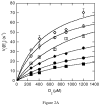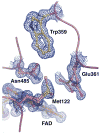The binding and release of oxygen and hydrogen peroxide are directed by a hydrophobic tunnel in cholesterol oxidase
- PMID: 18410129
- PMCID: PMC2561232
- DOI: 10.1021/bi800228w
The binding and release of oxygen and hydrogen peroxide are directed by a hydrophobic tunnel in cholesterol oxidase
Abstract
The usage by enzymes of specific binding pathways for gaseous substrates or products is debated. The crystal structure of the redox enzyme cholesterol oxidase, determined at sub-angstrom resolution, revealed a hydrophobic tunnel that may serve as a binding pathway for oxygen and hydrogen peroxide. This tunnel is formed by a cascade of conformational rearrangements and connects the active site with the exterior surface of the protein. To elucidate the relationship between this tunnel and gas binding and release, three mutant enzymes were constructed to block the tunnel or its putative gate. Mutation of the proposed gating residue Asn485 to Asp or tunnel residue Phe359 or Gly347 to Trp or Asn reduces the catalytic efficiency of oxidation. The K mO 2 increases from 300 +/- 35 microM for the wild-type enzyme to 617 +/- 15 microM for the F359W mutant. The k cat for the F359W mutant-catalyzed reaction decreases 13-fold relative to that of the wild-type-catalyzed reaction. The N485D and G347N mutants could not be saturated with oxygen. Transfer of hydride from the sterol to the flavin prosthetic group is no longer rate-limiting for these tunnel mutants. The steady-state kinetics of both wild-type and tunnel mutant enzymes are consistent with formation of a ternary complex of steroid and oxygen during catalysis. Furthermore, kinetic cooperativity with respect to molecular oxygen is observed with the tunnel mutants, but not with the wild-type enzyme. A rate-limiting conformational change for binding and release of oxygen and hydrogen peroxide, respectively, is consistent with the cooperative kinetics. In the atomic-resolution structure of F359W, the indole ring of the tryptophan completely fills the tunnel and is observed in only a single conformation. The size of the indole is proposed to limit conformational rearrangement of residue 359 that leads to tunnel opening in the wild-type enzyme. Overall, these results substantiate the functional importance of the tunnel for substrate binding and product release.
Figures









Similar articles
-
The presence of a hydrogen bond between asparagine 485 and the pi system of FAD modulates the redox potential in the reaction catalyzed by cholesterol oxidase.Biochemistry. 2001 Nov 20;40(46):13779-87. doi: 10.1021/bi010843i. Biochemistry. 2001. PMID: 11705367
-
A hydrogen-bonding network is important for oxidation and isomerization in the reaction catalyzed by cholesterol oxidase.Acta Crystallogr D Biol Crystallogr. 2009 Nov;65(Pt 11):1222-31. doi: 10.1107/S0907444909037421. Epub 2009 Oct 22. Acta Crystallogr D Biol Crystallogr. 2009. PMID: 19923719 Free PMC article.
-
Sub-atomic resolution crystal structure of cholesterol oxidase: what atomic resolution crystallography reveals about enzyme mechanism and the role of the FAD cofactor in redox activity.J Mol Biol. 2003 Mar 7;326(5):1635-50. doi: 10.1016/s0022-2836(03)00054-8. J Mol Biol. 2003. PMID: 12595270
-
Cholesterol oxidase: biochemistry and structural features.FEBS J. 2009 Dec;276(23):6826-43. doi: 10.1111/j.1742-4658.2009.07377.x. Epub 2009 Oct 16. FEBS J. 2009. PMID: 19843169 Review.
-
Dissection of a flavoenzyme active site: the reaction catalyzed by cholesterol oxidase.Antioxid Redox Signal. 2001 Oct;3(5):839-46. doi: 10.1089/15230860152665019. Antioxid Redox Signal. 2001. PMID: 11761331 Review.
Cited by
-
Uncovering channels in photosystem II by computer modelling: current progress, future prospects, and lessons from analogous systems.Photosynth Res. 2008 Oct-Dec;98(1-3):503-22. doi: 10.1007/s11120-008-9358-2. Epub 2008 Sep 17. Photosynth Res. 2008. PMID: 18798008 Review.
-
Oxygen reactivity in flavoenzymes: context matters.J Am Chem Soc. 2011 Oct 26;133(42):16809-11. doi: 10.1021/ja2081873. Epub 2011 Oct 4. J Am Chem Soc. 2011. PMID: 21958058 Free PMC article.
-
The gates of ion channels and enzymes.Trends Biochem Sci. 2010 Mar;35(3):179-85. doi: 10.1016/j.tibs.2009.10.007. Epub 2009 Nov 18. Trends Biochem Sci. 2010. PMID: 19926290 Free PMC article. Review.
-
Flavin-linked Erv-family sulfhydryl oxidases release superoxide anion during catalytic turnover.Biochemistry. 2012 Jan 10;51(1):265-72. doi: 10.1021/bi201672h. Epub 2011 Dec 16. Biochemistry. 2012. PMID: 22148553 Free PMC article.
-
Electrochemical Immobilisation of Glucose Oxidase for the Controlled Production of H2O2 in a Biocatalytic Flow Reactor.ChemElectroChem. 2022 Sep 13;9(17):e202200319. doi: 10.1002/celc.202200319. Epub 2022 Sep 8. ChemElectroChem. 2022. PMID: 36246851 Free PMC article.
References
-
- Tilton RF, Jr, Kuntz ID, Jr, Petsko GA. Cavities in proteins: structure of a metmyoglobin-xenon complex solved to 1.9 A. Biochemistry. 1984;23:2849–2857. - PubMed
-
- Whittington DA, Rosenzweig AC, Frederick CA, Lippard SJ. Xenon and halogenated alkanes track putative substrate binding cavities in the soluble methane monooxygenase hydroxylase. Biochemistry. 2001;40:3476–3482. - PubMed
-
- Duff AP, Trambaiolo DM, Cohen AE, Ellis PJ, Juda GA, Shepard EM, Langley DB, Dooley DM, Freeman HC, Guss JM. Using xenon as a probe for dioxygen-binding sites in copper amine oxidases. J Mol Biol. 2004;344:599–607. - PubMed
-
- de Sanctis D, Dewilde S, Pesce A, Moens L, Ascenzi P, Hankeln T, Burmester T, Bolognesi M. Mapping protein matrix cavities in human cytoglobin through Xe atom binding. Biochem Biophys Res Commun. 2004;316:1217–1221. - PubMed
-
- Raushel FM, Thoden JB, Holden HM. Enzymes with molecular tunnels. Acc Chem Res. 2003;36:539–548. - PubMed
Publication types
MeSH terms
Substances
Grants and funding
LinkOut - more resources
Full Text Sources
Other Literature Sources
Miscellaneous

